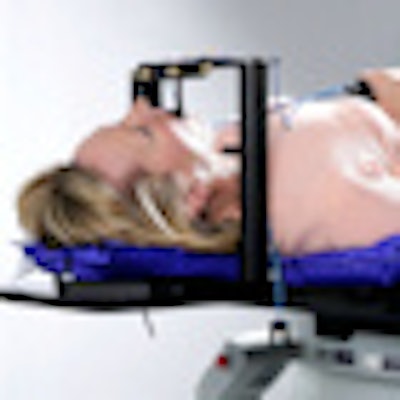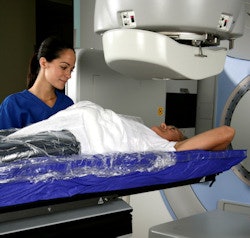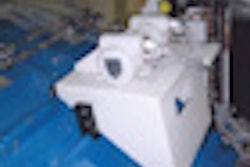
Proton therapy treatment is very expensive. And due to the scarcity of centers, access is limited. Therefore, efficient patient throughput is of paramount importance. Italian and Swiss researchers believe that remote positioning of patients may offer the potential of increasing patient throughput by up to 20%.
Using Monte Carlo simulations, the researchers compared throughput of patients in one-, two-, and three-room proton therapy centers of patients positioned both inside (in-gantry positioning) and outside (remote positioning) treatment rooms to determine the effect on workflow. After simulating a large variety of scenarios, the team concluded that more patients can be treated using remote positioning, but only under certain circumstances. A recent article published online in Radiotherapy and Oncology explained the details.
 For proton therapy cases that require firm yet gentle head fixation, clinicians may want to use a vacuum-activated head frame system. This one has a mouthpiece with the patient's upper palate impression and solid vacuum bonding with the hard palate. All images courtesy of Elekta.
For proton therapy cases that require firm yet gentle head fixation, clinicians may want to use a vacuum-activated head frame system. This one has a mouthpiece with the patient's upper palate impression and solid vacuum bonding with the hard palate. All images courtesy of Elekta.
Patient positioning is a time-consuming task which affects patient throughput. For this reason, a decision has to be made by a proton therapy center as to whether it is beneficial to position the patient remotely and then transfer them to the treatment room, or to carry out positioning in-gantry.
"There are claims that remote positioning systems can increase the number of patients treated by as much as 30% to 40%, but there is no published evidence," explained Dr. Lamberto Widesott from AtreP, the Agenzia Provinciale per la Protonterapia in Trento, Italy. "We wanted to investigate this in detail. I hope our analysis will help future proton centers to envisage the possible impact such technology would have in their specific context."
Analyzing all the facts
Today's proton centers have two options when it comes to positioning: in-room positioning, where the full procedure takes place in the treatment room, or remote positioning where the patient is prepared in a separate room and transported to the nearby treatment room by robotic or manual means. The only proton center currently using remote positioning is the Paul Scherrer Institute in Villigen, Switzerland.
Widesott and his colleagues, and collaborators at St. Raffaele Scientific Institute in Milan and the Paul Scherrer Institute, used modified Monte Carlo software developed in Villigen. They simulated both the in-room positioning and remote positioning schemes, as well as factors such as the number (two or three) and speed of the robotic transporters, the image and set-up correction system, the number of treatment rooms, the method used to switch the beam, and the waiting time patients experienced between different treatment phases.
For facilities running a single treatment room, the simulations showed that an average of 20% more patients could be treated when remote positioning is employed instead of in-room positioning. This equates to about four additional patients over a 13-hour period. The researchers were keen to stress, however, that when the speed of transport is slow and the imaging and set-up correction system involved in patient positioning is fast, fewer patients are treated using remote positioning compared with in-room positioning.
For two gantries, about six additional patients in a 13-hour period could be treated with remote positioning, a 10% increase. Moving up to three treatment rooms did not affect the throughput, as both types of positioning systems showed similar results.
 A dual vacuum immobilization system can be used in select proton therapy cases (e.g., pancreatic cancer) to provide noninvasive, accurate, and reproducible patient positioning and breathing motion reduction.
A dual vacuum immobilization system can be used in select proton therapy cases (e.g., pancreatic cancer) to provide noninvasive, accurate, and reproducible patient positioning and breathing motion reduction.
Commenting on these findings, Widesott said: "The more complex and time consuming the procedure for positioning the patient, the more reasonable it is to do that procedure out of the gantry. The speed of the robotic transporter should be as fast as possible, compatible with the comfort and immobilization of the patient. For some tumors types, clinicians prefer in-room positioning as it minimizes the time between positioning and treatment."
Added considerations
The analysis also revealed that the frequency of patient appointments and, in turn, the amount of time each patient has to wait between treatment phases, is critical. "To decrease waiting times, it will be fundamental to employ computerized management," said Widesott. "Here a computer would evaluate the treatment time, delays, imaging procedures, etc., for each patient and call them at the appropriate moment."
It is also important to realize that while remote positioning could increase the number of patients being treated, the parallel nature of the system means that staffing levels are higher. "It is a case of weighing up the cost of the remote positioning technology and the complexity and rigidity that the management of such technology brings," Widesott told medicalphysicsweb. "Another point worth noting is that remote positioning opens the possibility of using MRI to position the patient. This is an interesting option for pediatric patients, as it avoids a daily CT scan."
The publication date for the study was 25 November 2011.
© IOP Publishing Limited. Republished with permission from medicalphysicsweb, a community website covering fundamental research and emerging technologies in medical imaging and radiation therapy.


















